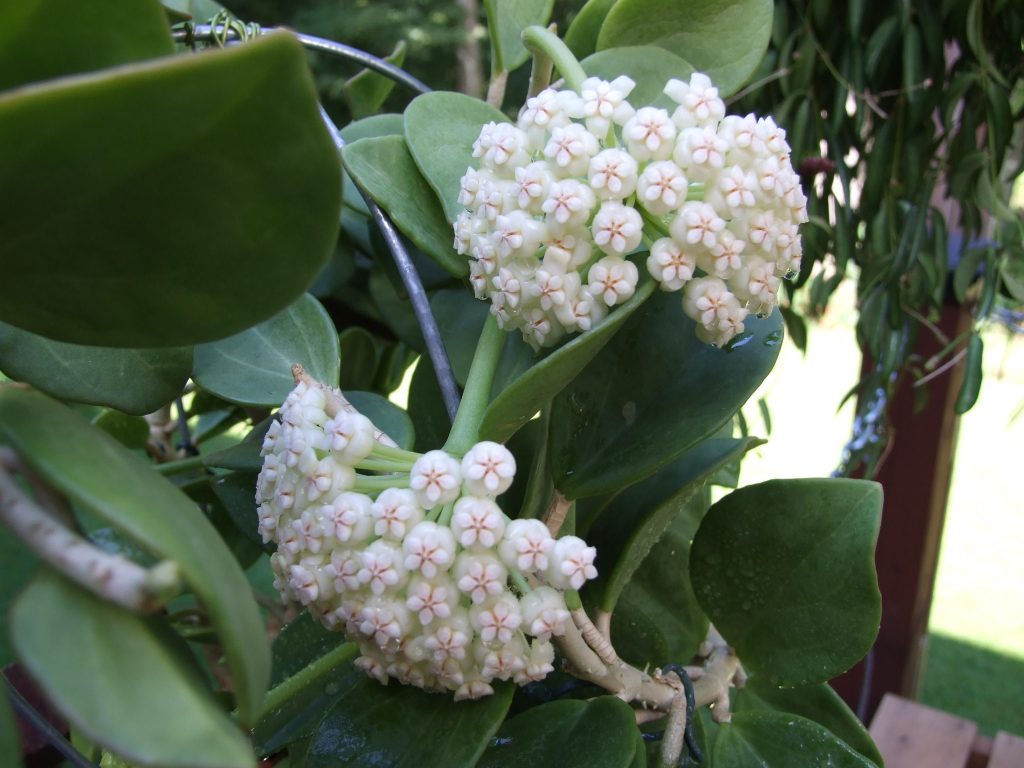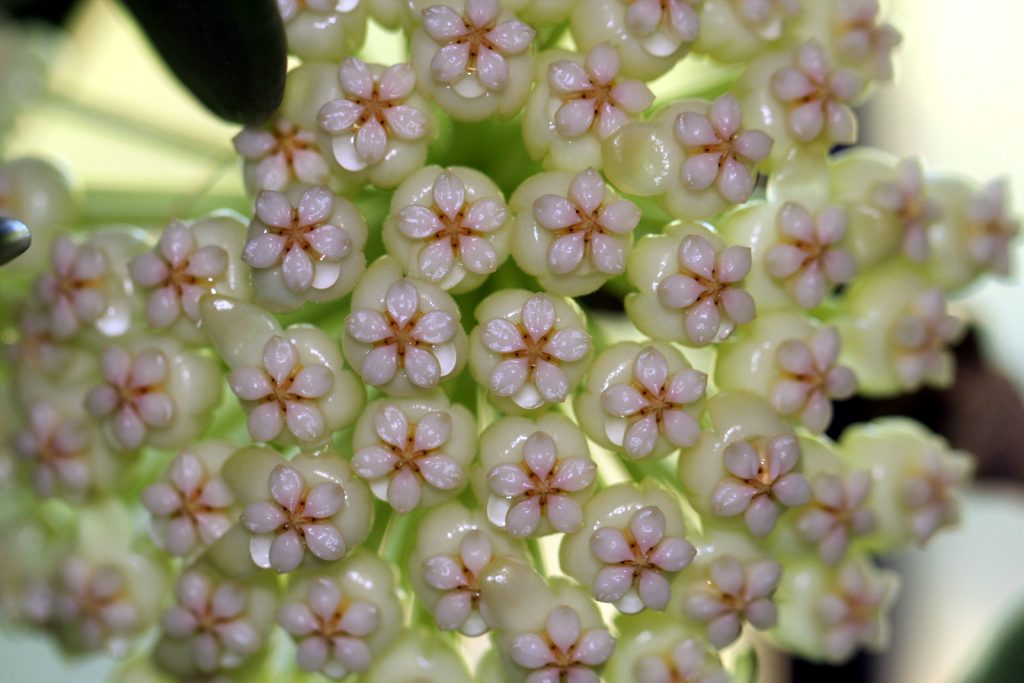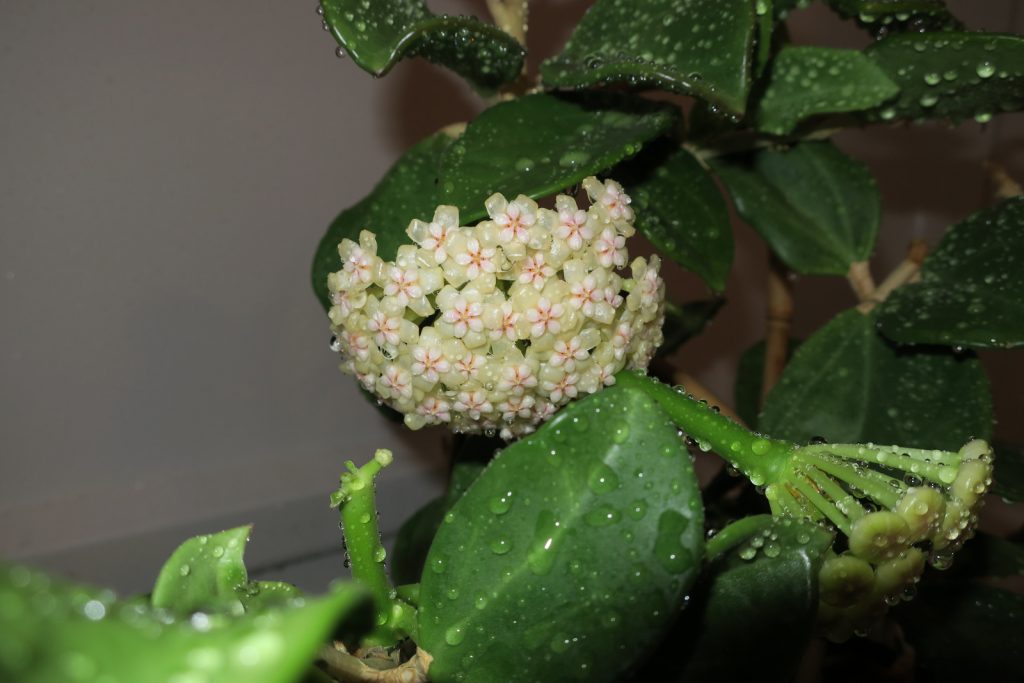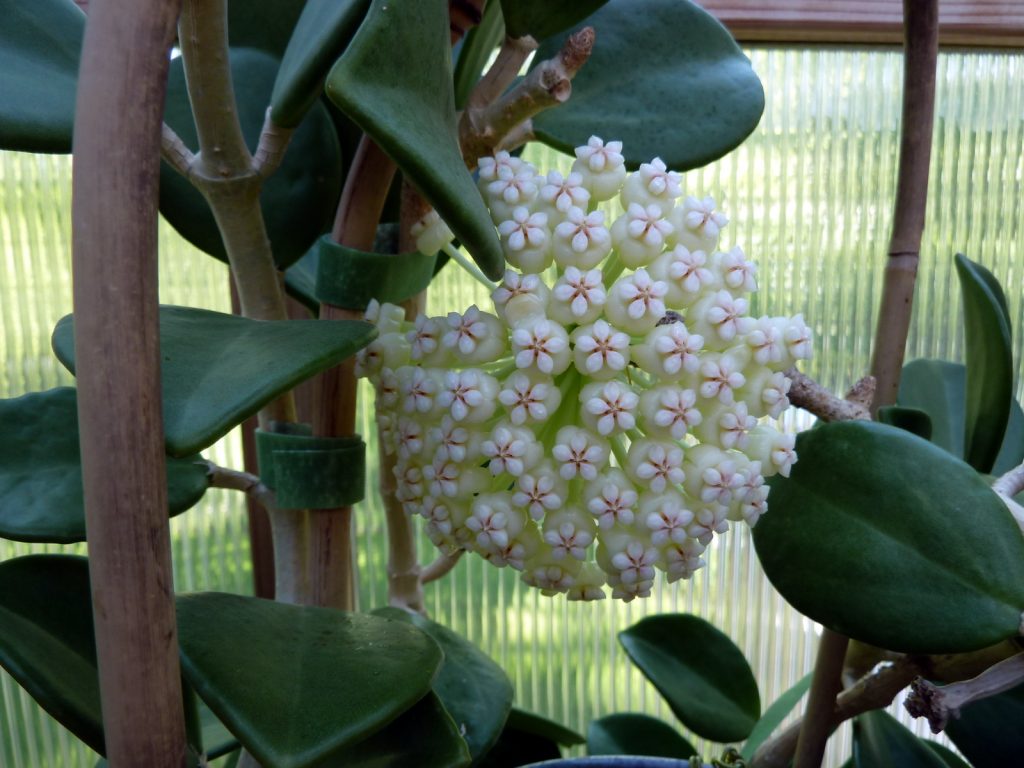Hoya Pachyclada - the intricacies of growing
Hoya Pachyclada variegated is an exotic plant, whose homeland is considered to be Southeast Asia. It grows in Australia and the Polynesian Islands. In common people it is called wax ivy.

Hoya pachyclada description
Description of the plant
Hoya Pachyclada is an epiphyte with dense vegetative shoots up to 10 cm long, requiring vertical support. Variegata leaves are round in shape with a thin lighter border around the perimeter.
Peduncles are small in size. Combine about 20 buds of an umbrella type of white color with a yellowish tint and a crimson core. The aroma is intense, sweet, with notes of perfume.
Purchase and adaptation
After the purchase, the flower is immediately placed in isolation in order to identify possible diseases and the vital activity of pests. If no symptoms are found after at least 2 weeks, the pot is moved to the rest of the houseplants.
Additionally, the culture is transplanted into a new container with the obligatory replacement of the soil with a more suitable one - the shipping one is not saturated with all the necessary nutrients, which does not allow the succulent to develop actively.
Landing rules
During planting, it is necessary to disturb the root system of the succulent to a minimum. Exceptions are situations when flower roots are injured due to illness or insect activity. They try to position the neck of the plant at the same level relative to the soil surface.

Hoya pachyclada
The pot for the epiphyte is chosen small in size, on average exceeding the previous one by 2 cm in diameter. In a larger container, the culture does not enter the flowering stage for an extremely long time, mastering the contents of the container.
Selection of soil and location
Hoya prefers light soils with a high degree of water and air permeability. When choosing a universal substrate, preference should be given to modifications with a neutral or slightly acidic medium.
You can also make up the soil mixture yourself by choosing any of the most suitable options:
- peat soil, crushed tree bark, coconut fiber, perlite in a ratio of 1: 1: 1: 1;
- garden soil, perlite, vermiculite, sphagnum at the rate of 2: 1: 1: 1;
- turf, peat, vegetable humus, river sand, leafy soil - 1: 1: 1: 1: 2.
The optimal location for a flower is windows with a southwest or southeast orientation.
If you can put a pot with an exotic beauty only on the southern windowsill, you should take care of shading the plant in order to prevent sunburn.
The necessary conditions
Lighting
Hoya is demanding on lighting, but does not tolerate direct exposure to the sun.

Hoya pachyclada variegata
In this regard, it is better to place the pots as close as possible to the window glass, thereby creating optimal insolation - in this position, the rays will be refracted and the epiphyte will receive the necessary dose of scattered light.
Humidity
Room humidity should be kept moderate. During the heating season and especially hot summer weather, the plant should be periodically sprayed with soft water from a spray bottle.
Temperature
Room Hoya is thermophilic. Extremely sensitive to temperature changes and drafts.
The temperature in the room is regulated in relation to the stage in which the culture resides:
- during the growing season, 18-25 ° C are considered optimal;
- in the resting phase, which occurs in the winter months, the indicators are maintained at 15-17 ° C.
A mark of 10 ° C is critical for a succulent and can lead to the death of the plant.
Care
Watering
Water the plant in the summer about once a week, in the winter season, the interval between procedures is increased by 2-3 times. In this case, the degree of moisture absorption into the substrate should be monitored - the roots should have time to absorb it after the previous irrigation, but not be overdried.

Hoya pachyclada photo
If liquid remains in the pan, it is necessary to wait about half an hour, and then drain the excess.
Water is used standing, heated to room temperature. Cold, especially during the heat in summer, is categorically contraindicated.
Top dressing
Hoya needs additional nutrients only in the phase of active growth, which occurs in the spring-summer.
The plant is fed with liquid universal preparations with a mineral complex, strictly observing the dosage on the package of the product. In this case, the composition is applied not to the roots, but along the edge of the container.
Transfer
The transplant is carried out only as needed, as evidenced by the roots visible from the drainage holes. The procedure can be done both in a transhipment way and by washing the roots from the old substrate beforehand.
During the process, the plant is carefully examined, if damaged segments are present, they are stopped and treated with a solution of potassium permanganate or systemic drugs.
Pruning
Wax ivy needs pruning only in case of damage by pests or diseases, as well as in case of excessive growth. All manipulations are done with a sharp pruner or scissors, placing a cut between the growth nodes. Shoots with faded buds cannot be sheared - new inflorescences will form in their place in the future.
Reproduction methods
Seeds
The seed breeding method of Hoya is practically not used in home floriculture. Indoor exotic does not form seeds; they can be purchased only in a specialized store. The process itself is quite laborious and takes a lot of time.

Hoya pachyclada variegated
Cuttings
The most productive method by which it is possible to propagate a plant. Last year's vegetative shoots are used as seed.
Rooting technology for cuttings:
- With a sharp tool, cut off a shoot with a length of no more than 7 cm so that several leaf plates and growth points are present on it. In this case, the cut is made below the extreme knot by 2-3 cm.
- The shoot is processed in a biostimulator of root formation, then placed in a base (sand, soil mixture, water) and covered with polyethylene to create a greenhouse effect.
- Provide a room temperature of at least 20 ° C.
- A month later, they are transplanted to a permanent place. Additionally, pinch the top to stimulate further flowering.
Layers
For reproduction of Hoya, an incision is made on the stem by layering, which is covered with wet moss and a film is stretched over it. After the roots appear, the branch is completely separated from the mother plant and planted in a pot.
Diseases and pests
| Problem | Symptoms | Prophylaxis | Treatment |
| Mealybug | The stem is deformed, the growth of the plant is inhibited. Leaves curl, turn yellow, fall off. There is a cottony bloom on the surface. | Faded buds are regularly removed, fertilized in a timely manner, watered moderately | They are treated with chemicals: Confidant, Aktara, Confidor, Calypso, Tanrek. Infusions of garlic, calendula, lemon peel, oil emulsion also help. |
| Spider mite | Suspension in development, blotches of black or reddish tint on the seamy side of the leaf plates. Drying leaves, a whitish spider web. | From time to time they wash under a warm shower with laundry or tar soap. | They are treated with soapy water or systemic agents such as Aktara, Fitoverm, Aktellik. Additionally, it is allowed to use vodka diluted with water, infusion of dandelion or garlic. |
| Root rot | Slow growth, pigmentation, brown spots on the surface. The flower softens, fades. | Before planting, the substrate is disinfected, fertilizer application rates are observed, and plant residues are removed | The plant is transplanted into new soil and a pot, rotten segments are removed and the sections are disinfected. They are treated with fungicidal preparations (Trichodermin, Topaz, Previkur Energy, Mikosan, copper sulfate, Glyocladin) |

